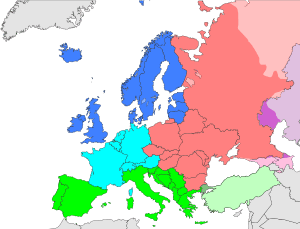Eastern Europe facts for kids
Eastern Europe is the eastern part of Europe. It's a big region, and people have different ideas about which countries belong there.
Long ago, in the Middle Ages, Eastern Europe often meant countries that followed the Eastern Orthodox Church. This was different from Western Europe, where people mostly followed the Roman Catholic Church.
Later, during the Cold War (from the 1940s to the early 1990s), Eastern Europe usually referred to countries that were closely connected to the Soviet Union. Many people still use this idea today.
Another way to think about Eastern Europe is by its cultures. Many people there are Slavic, meaning they share similar languages and traditions. But many other groups of people live there too!
Contents
Which Countries Are in Eastern Europe?
The UN and the EU have a wide list of countries they consider part of Eastern Europe. Here are some of them:
 Albania
Albania Belarus
Belarus Bosnia and Herzegovina
Bosnia and Herzegovina Bulgaria
Bulgaria Croatia
Croatia Cyprus (This island is between Europe and Asia)
Cyprus (This island is between Europe and Asia) Czech Republic
Czech Republic Estonia
Estonia Georgia (This country is also between Europe and Asia)
Georgia (This country is also between Europe and Asia) Greece
Greece Hungary
Hungary Kazakhstan (A very large country, also between Europe and Asia)
Kazakhstan (A very large country, also between Europe and Asia) Latvia
Latvia Lithuania
Lithuania North Macedonia
North Macedonia Moldova
Moldova Montenegro
Montenegro Poland
Poland Romania
Romania Russia (The largest country in the world, also between Europe and Asia)
Russia (The largest country in the world, also between Europe and Asia) Serbia
Serbia Slovakia
Slovakia Slovenia
Slovenia Turkey (This country is also between Europe and Asia)
Turkey (This country is also between Europe and Asia) Ukraine
Ukraine
Some areas are only partly recognized as independent countries, but are also seen as part of this region:
Different Ways to Define the Region
Since the 1990s, some experts have started to think about Eastern Europe in new ways. While the list above is very common, some people divide the region into smaller parts.
For example, countries like the Czech Republic, Hungary, Poland, and Slovakia are sometimes called Central Europe. This means they are seen as being in the middle of Europe.
Other countries, like Albania, Bosnia and Herzegovina, Bulgaria, Croatia, Kosovo, North Macedonia, Moldova, Montenegro, Romania, and Slovenia, are sometimes grouped into Southern Europe. More often, they are called Southeast Europe.
Images for kids
See also
 In Spanish: Europa Oriental para niños
In Spanish: Europa Oriental para niños




